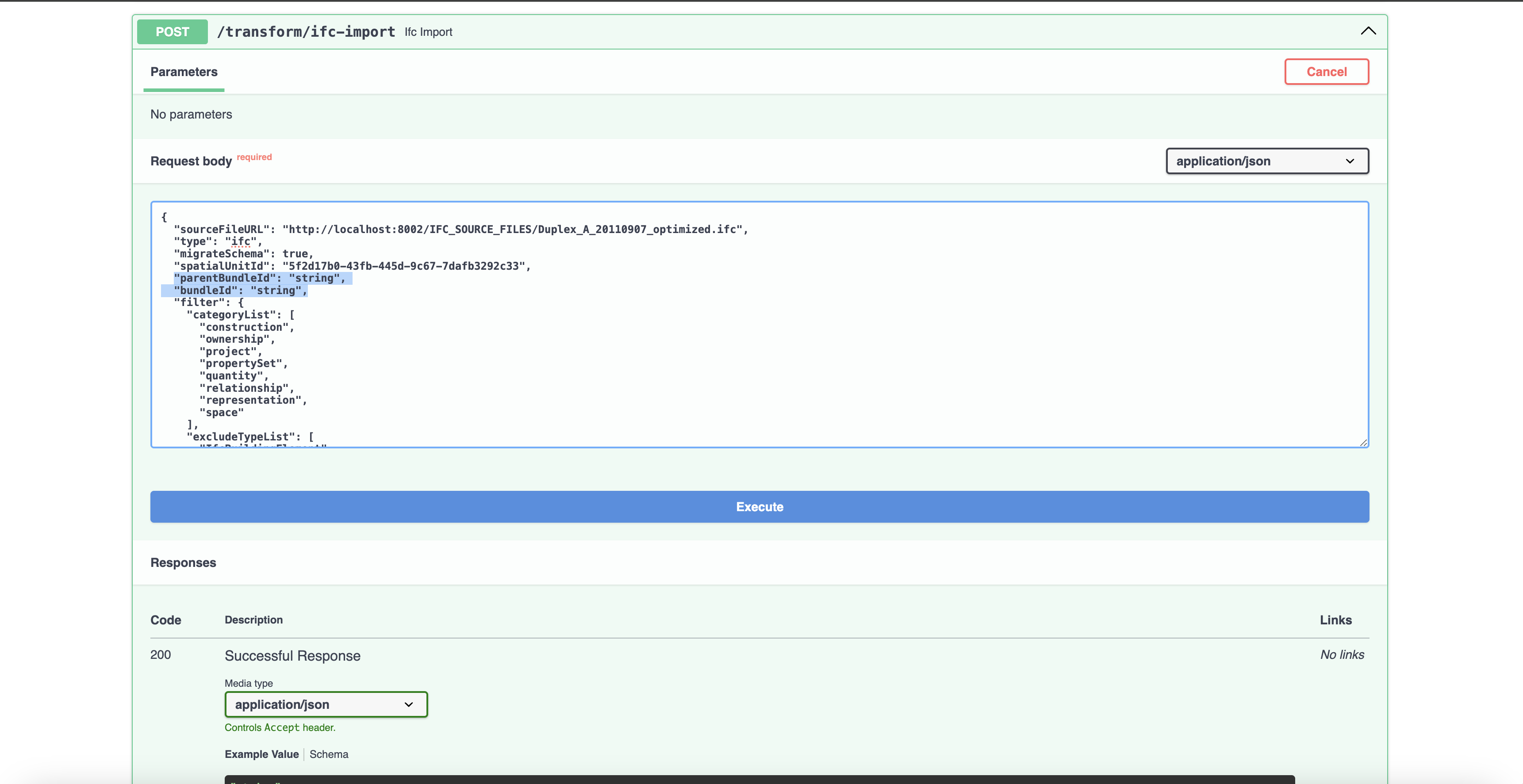Import an IFC2X3, IFC4 or IFC4X3 and transform it to an ifcJSON
The capability which is demonstrated here is simple: we can import an IFC (Step file) from a remote source and tranform it to an ifcJSON that will be available for the next steps in a straight-through processing manner
Submit the processing request
Import is started by sending a POST with a Json Body as defined in pydantic
class ImportFilter(BaseModel):
categoryList: list[Literal['construction','furniture','group','material','ownership','project','propertySet','quantity','relationship','representation','space','system']] | None = ['construction','group','material','ownership','project','propertySet','quantity','relationship','representation','space']
excludeTypeList: list[str] | None = ['IfcBuildingElement','IfcBuildingElementPart','IfcBuildingElementProxy','IfcBuildingElementProxyType']
class TesselateElements(BaseModel):
elementTypes: list[str] | None = ["IfcWall,IfcWallStandardCase,IfcSlab,IfcBeam,IfcColumn,IfcWindow,IfcDoor,IfcSpace"]
forcedFacetedBREP: bool | None = False
class ImportInstruction(BaseModel):
sourceFileURL: str | None = "http://localhost:8002/IFC_SOURCE_FILES/AC20-FZK-Haus.ifc"
modelType: Literal['ifc']
migrateSchema: bool | None = False
tessellate: bool | None = True
spatialUnitId: str | None = "b6fc5402-ca87-47ba-a9f4-e29173d51656"
parentBundleId : str | None = None
bundleId: str | None = None
withFilter: bool | None = False
filter: ImportFilter
tessellateElements: TesselateElements
FastAPI provides by default at /docs a swagger utility that simplifies the execution of tests.
The request provides:
- default values that must be adjusted to your specific case
- the filter (more on that in filter the model)
- the option to migrate the schema in the IFC file. This applies only to the migration from IFC2X3 to IFC4. There is no migration for IFC schema IFC4 and IFC4X3 and the value of migrateSchema will be ignored
- the option to tessellate the representation of the products (IfcWall, IfcSlab, ...). To be tessellated, an IFC2X3 must also be migrated to IFC4 (migrateSchema = True). Tessellation is based on IfcPatch with recipe = 'TesselateElements'. The default list of elements is [].
For a new primary import, the parentBundleId and the bundleId must be None, i.e. removed from the request.
Service the request
This is done in the Service Layer where a chain of task is composed and sent for execution by a Celery Worker via a message in the Message Broker(Redis)
Get IFC from a remote location
Currently all IFC files are store locally and served with Nodejs http-server.
Migrate the IFC file from IFC2X3 to IFC4 with IfcPatch
This is done with the IfcPatch 'Migrate' recipe before the conversion to ifcJSON provided that migrateSchema is set to True.
Create the ifcJSON with IFC2JSON
Read file and create ifcjson model with NO_INVERSE=True.
Create the Bundle and Update the bundleJournal
flowchart TB
bundle
bundleJournal
spatialUnit
bundleUnit
spatialUnitBundleUnit
spatialUnitBundleUnit --o bundleUnit
spatialUnitBundleUnit --o spatialUnit
bundle --o bundleUnit
bundle --o bundleJournalThe database is updated with:
- an entry in the bundle table
- an entry in the bundleJournal table
- an entry in the bundleUnit as a root entity (the project)
- an entry in the spatialUnitBundleUnit table
Issues (will need a follow-up)
Note
Tessellate does not maintain the style (this is a known feature / bug). In the present state, tesselation should better not be used on the primary import.
Note
Error with IfcExternalReference not supported. When present, I get the following error: 'AttributeError("entity instance of type 'IFC4.IfcExternalReference' has no attribute 'wrappedValue'")
Note
with NO_INVERSE = False for LARGE_MODEL_20210219Architecture.ifc, the program got stuck somewhere. I stopped after 23m 53.2s
